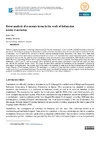Identificador persistente para citar o vincular este elemento:
https://accedacris.ulpgc.es/jspui/handle/10553/76164
| Campo DC | Valor | idioma |
|---|---|---|
| dc.contributor.author | Sari, Indah | en_US |
| dc.date.accessioned | 2020-12-01T10:52:25Z | - |
| dc.date.available | 2020-12-01T10:52:25Z | - |
| dc.date.issued | 2020 | en_US |
| dc.identifier.issn | 2340-8561 | en_US |
| dc.identifier.uri | https://accedacris.ulpgc.es/handle/10553/76164 | - |
| dc.description.abstract | There is a greater demand for a wider range of translation services that increasingly involve scientific, commercial, legal, or technical documents. Translation is no longer limited to literary works which have historically been the main focus of the translation industry in Indonesia. As it is believed that university is the best place for translator training (Bernardini, 2004; Maia, 2012), there have been attempts to put legal and economic translation into the curriculum with the premise that students should be exposed to different types of text to ensure that the materials used in translation classes are relevant to market needs (Kelly, 2000; Heidari and Mowlaie, 2016) However, translating business texts is quite challenging for students because it requires knowledge of text type and genre differences in the SL and TL, and the awareness of the relationship between context and register in terms of field, mode, and tenor are vital for the translator (Beeby, 2000). This paper discusses errors produced by Indonesian novice translators in translating terminology in business texts. The samples used in this study were produced by students at the English Department of Politeknik Negeri Padang in West Sumatra, Indonesia. The institution is a vocational college that trains students in practical competencies, including to work as professional translators. The aim of this paper is to identify the strategies used by students in solving translation problems in an effort to better understand the issues faced in the field of translation in Indonesia. | en_US |
| dc.language | eng | en_US |
| dc.relation.ispartof | LFE. Revista de Lenguas para Fines Específicos | en_US |
| dc.source | LFE. Revista de lenguas para fines específicos [eISSN 2340-8561], v. 26 (1), p. 122-132 | en_US |
| dc.subject | 570107 Lengua y literatura | en_US |
| dc.subject | 550510 Filología | en_US |
| dc.subject.other | Errors | en_US |
| dc.subject.other | Translation | en_US |
| dc.subject.other | Economic | en_US |
| dc.subject.other | Terminology | en_US |
| dc.title | Error analysis of economic terms in the work of indonesian novice translation | en_US |
| dc.type | info:eu-repo/semantics/article | - |
| dc.type | Article | - |
| dc.identifier.doi | 10.20420/rlfe.2020.317 | en_US |
| dc.description.lastpage | 132 | en_US |
| dc.description.firstpage | 122 | en_US |
| dc.relation.volume | 26 | en_US |
| dc.investigacion | Artes y Humanidades | en_US |
| dc.type2 | Artículo | - |
| dc.identifier.ulpgc | Sí | en_US |
| dc.description.esci | ESCI | |
| dc.description.fecytq | Q3 | |
| dc.description.fecytpuntuacion | 27,02 | |
| dc.description.dialnetimpact | 0,0 | |
| dc.description.dialnetq | Q1 | |
| dc.description.dialnetd | D1 | |
| dc.description.erihplus | ERIH PLUS | |
| item.grantfulltext | open | - |
| item.fulltext | Con texto completo | - |
| Colección: | Artículos | |
Visitas
127
actualizado el 07-dic-2024
Descargas
115
actualizado el 07-dic-2024
Google ScholarTM
Verifica
Altmetric
Comparte
Exporta metadatos
Los elementos en ULPGC accedaCRIS están protegidos por derechos de autor con todos los derechos reservados, a menos que se indique lo contrario.
